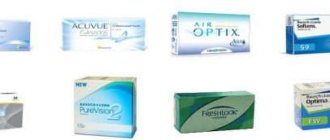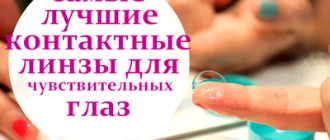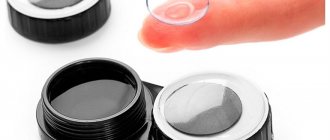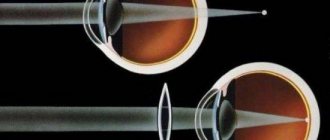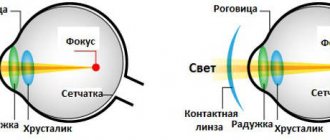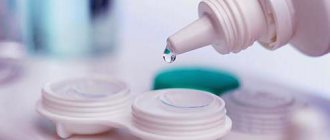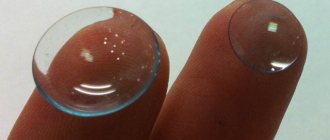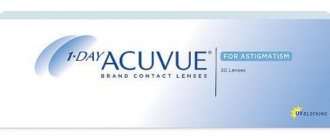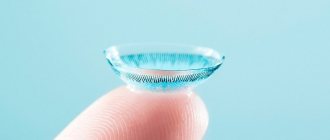Modern contact lenses, based on the material from which they are made, are divided into two types: soft and hard. Many people are accustomed to using the first option - contact optics made of soft polymers. In fact, hard lenses are no worse, and in some ways they are even superior to their “competitors”.
If you previously used glasses and are now thinking about switching to contact lenses, then you will be interested to know what advantages these ophthalmic products have.
Hydrogel lenses
Soft lenses made from hydrogel polymers have the highest compatibility with the tissues of the organs of vision - this is their main advantage. The air in them is supplied to the cornea of the eye mainly with the help of water molecules, since the oxygen permeability of this material is quite low (not higher than 40 units).
Hydrogel SCLs are the softest and thinnest. On the one hand, this can be considered their advantage, because they are practically not felt on the eyes, but on the other hand, they are less durable than silicone hydrogel analogues and can be easily damaged during operation. In addition, some users have difficulty putting on and taking off such thin lenses.
Silicone hydrogel lenses
As the name suggests, these lenses are made of two materials: silicone and hydrogel. The hydrogel component ensures the compatibility of the contact lens with the tissues of the eye and avoids possible rejection, and the silicone part guarantees the supply of sufficient oxygen to the cornea. Modern silicone hydrogel SCLs have an oxygen permeability level Dk/t of up to 160 units. The highest performance is observed in Air Optix lenses from Alcon (CIBA Vision) and PureVision from Bausch&Lomb. These lenses can be worn without removing them before bed, without the risk of hypoxia throughout the week.
Another advantage of silicone hydrogel contact optics is that they contain less moisture, which means that evaporation does not affect the usability of lenses as much.
Silicone hydrogel SCLs, as mentioned above, are somewhat denser than hydrogel ones, therefore they are less susceptible to mechanical damage, but can still be felt by the eyes.
When selecting silicone hydrogel contact lenses, specialists pay special attention to determining the radius of base curvature. Since these SCLs are quite rigid, if this indicator is calculated incorrectly, a feeling of discomfort may occur. Also, before making a purchase, silicone hydrogel lenses should be tried on to ensure sufficient mobility of the lenses and their correct fit.
The most popular today are soft contact lenses made from silicone hydrogel materials, however, hydrogel ones also have their fans. The choice of material is a matter of individual preference.
Species and types
There are many types and types of CL depending on various characteristics. Based on the structure of the material used in manufacturing, hard and soft lenses are distinguished.
Hard ones require a long time to get used to; they are less adapted to the structure of the eyes and do not provide adequate nutrition. Positive qualities are strength and wear resistance, long service life, resistance to protein deposits, and the ability to keep its shape well. They do not contain water, and therefore there is no need to use moisturizing drops when using them.
Indications for use: severe deviations in refraction, astigmatism, keratoconus. Among hard lenses, there are gas-tight (do not allow oxygen to pass through) and gas-permeable (promoting the penetration of oxygen to the eye tissues). Representatives of this type are the brands Whoelk and Boston.
Hard contact lenses
Soft (SCL) are the most common at present. They are more physiological, elastic, but less durable than rigid ones. Often these corrective products are subject to tears and contamination with bacteria. Their advantages are comfort to wear and the passage of large amounts of oxygen to the eyes.
Hydroxyethyl methacrylate (HEMA), hydrogel and its combination with silicone are used as raw materials for their production. The most well-known representatives of SCL are brands with the following names: Acuvue Oasys, Pure Vision, AirOptix, Soflens, Biomedics, Dailiess, Maxima, Optima, BioTrue.
Representatives of soft contact lenses
For SCLs, terms and modes of wearing them have been developed. They are divided into the following types:
- One-day. This type involves using a new pair every day. The positive side of this is that there is no need for care; in the evening the lenses just need to be thrown away.
- Frequent replacement. In this case, the old pair is replaced with a new one at least 2 times a month (once every 1 or 2 weeks).
- Planned replacement. Contact lenses of this type must be replaced monthly, quarterly or every six months. Replacement lenses require care in the form of storage in a container in a special solution.
Depending on the wearing mode, there are also daily and continuous wear lenses. The first type can be worn only during the day, with a break at night. The second type is allowed not to be removed at night, and some models can even be worn constantly throughout the week. Basically, all manufacturers have brands of both wearing modes in their arsenal.
According to the function performed, there are corrective, therapeutic and cosmetic varieties. The latter are designed to change eye color and create various effects (cat's eye, vampire and others).
Color contact lenses
Some effects created by contact lenses
Lenses in this line are available from the following brands: Carl Zeiss, AirOptix, FreshLook, Adria, AquaMax, Biomedics, Focus, Fusion, Soflens, Maxima, OFTAlmix.
Therapeutic, or as they are also called, bandages, are used to prolong the effect of medications instilled into the eye. They act as an aseptic dressing, concentrating the medicine in the lesion, reducing the evaporation of tears from the surface of the cornea, and promoting faster healing. These lenses are made of silicone hydrogel with a high oxygen transmission index. These characteristics correspond to Acuvue Oasys (JonsonJonson), Pure Vision (BaushLomb), Airoptix Night Day (CIBA Vision).
Corrective lenses are available with different refractive powers for vision correction. They can be transparent and colored. Corrective contact lenses are classified by shape and structure:
- spherical, used to correct myopia or hyperopia,
- topical, correcting astigmatism,
- multifocal, which have several foci and are used for presbyopia.
Almost every brand has lines with the above types to correct all types of refractive errors.
Who are soft lenses for?
They suit almost everyone. There are few contraindications to them. Production technologies are improving, soft lenses are becoming more and more comfortable. Medical indications for them are the following pathologies:
- myopia;
- farsightedness;
- astigmatism;
- presbyopia.
To correct the first two refractive errors, lenses with a spherical or aspherical design are used. They differ in the shape of the inner or outer surface. Most ophthalmic products are made in the form of a sphere. They cope well with the first and middle degrees of myopia and hypermetropia. Popular models of this type:
- IQLens Oxygen 1-day - hydrogel ophthalmic products for daily replacement;
- ACUVUE Oasys with Hydraclear Plus - silicone hydrogel lenses with a two-week replacement schedule;
- Air Optix plus HydraGlyde - contact optics for a month, which can be worn over an extended period of time;
- Optima FW is a quarterly model designed for 3 months;
- Infiniti - traditional soft lenses, which last 6 months.
Contact optics with an aspherical design compensate even for very severe forms of myopia and hypermetropia, providing clear and contrasting vision without glare in any lighting. Famous aspherical lenses:
- one-day - Dailies AquaComfort Plus, Ochkov.Net 1-Day;
- monthly - Avaira, Biomedics 55 Evolution UV, PureVision;
- quarterly - Adria Season.
Toric contact lenses correct astigmatism. They also correct one of the associated pathologies - myopia or farsightedness. Just a few years ago, people had to wear ugly and uncomfortable astigmatic glasses. Today, the choice of contact optics with toric design is more than diverse:
- for one day - ACUVUE OASYS 1-Day with HydraLuxe™ for Astigmatism;
- for 2 weeks - ACUVUE Oasys for Astigmatism;
- for a month - Biofinity Toric, Bioclear Toric.
Multifocal contact lenses are equipped with several optical centers - for distance, near and intermediate vision. They are suitable for the correction of presbyopia. The choice of models of this type is small. The most famous:
- Dailies Total1 Multifocal - water-gradient daily lenses;
- Biofinity Multifocal - monthly ophthalmic products you can sleep in;
- 1-Day ACUVUE Moist Multifocal is a hydrogel contact optic with a high moisture content of 58%.
Types of contact lenses
As ophthalmology develops, more and more varieties of contact lenses appear. Today, several criteria for their classification can be distinguished. First of all, lenses are divided according to the material of manufacture into two large categories - hard and soft.
Soft contact lenses
Soft contact lenses are the most common: they are worn by 9 out of 10 patients prescribed this vision correction product. These are flexible lenses created on a hydro-based basis. They fit comfortably on the eye and do not interfere with oxygen circulation.
Their characteristics:
- prescribed for myopia and farsightedness (including age-related), as well as for mild forms of astigmatism;
- do not cause discomfort;
- do not require getting used to;
- absorb moisture;
- with proper hydration, they do not allow the eye to dry out.
Types of soft lenses:
A) Hydrogel
– lenses created from polymers and water. They can be worn throughout the day, but by evening the eye will begin to feel dry. Hydrogel lenses can be classified according to their water content:
- low-hydrophilic - less than 50% moisture (recently practically not used);
- medium hydrophilic – from 50 to 80%;
- highly hydrophilic - more than 80% (inferior to the previous ones due to the tendency to dehydration).
B) Silicone hydrogel
– lenses based on a combination of polymer and silicone. This type is characterized by greater elasticity and high oxygen permeability. If there is no individual sensitivity to silicone, these lenses can be worn without removal for about a month.
In addition, soft contact lenses are divided into groups according to the shape of the surface of the optical zone
:
- spherical contact lenses – designed to correct myopia (nearsightedness) and hypermetropia (farsightedness);
- multifocal contact lenses – used for presbyopia (age-related farsightedness);
- toric contact lenses - help with astigmatism above 1 diopter (before this, you can get by with spherical ones);
- aspheric contact lenses - used for all the diseases described above to eliminate focal mismatches, if necessary.
Hard contact lenses
When soft options do not bring the desired effect, the patient is prescribed hard contact lenses. Unlike soft ones, which can be bought in optics, they are produced for a specific patient by special order. The laboratory ensures that the shape of the cornea and the inside of the hard lens match as closely as possible.
Their characteristics:
- recommended when changing the shape of the cornea;
- felt while wearing;
- require getting used to;
- gas permeable;
- have a longer (compared to soft) service life;
- not susceptible to protein deposits in the eye;
- do not interfere with tear exchange;
- do not require additional moisture.
Rigid lenses have a peculiarity: if the patient wants to abandon them and return to vision correction with glasses, the latter may not work. Such lenses slightly deform the cornea, and the glasses cease to fulfill their role. After some time, this side effect goes away.
Contact lenses according to wearing regimen
In addition to the classification of contact lenses by material of manufacture (and accompanying characteristics), another grouping is possible, for example, by wearing mode
In accordance with the wearing mode, there are:
- daily (one-day) – intended for one-time use, characterized by high oxygen permeability and recommended for people with sensitive eyes;
- extended - lenses that can be worn for up to a week, removing only before bed;
- flexible – lenses in which you can sleep without risking your eye health (the main thing is not to wear them continuously);
- continuous – recommended for wearing for a month: they have properties that provide eye hydration, so they can be left on for 30 days.
Ophthalmologists do not recommend that people who have no experience using contact lenses start with continuous lenses. Until the eye has adapted to such a means of correction, it is better to remove the lenses more often.
Special purpose contact lenses
Sometimes contact lenses are used not only to correct vision, but also to change the color of the iris. They should not be confused with tinted ones: such options are created only to improve the visualization of the lens itself. They do not directly affect eye color. In turn, colored lenses come in the following types:
- tinted – make your own eye shade more expressive and rich;
- intensely colored – allow you to radically change the color of the iris;
- with drawings - giving the eye a fantastic look.
Separately, it is worth noting scleral contact lenses. They change the color of not only the iris, but also the surrounding sclera. The result is an “alien eye” effect.
Sometimes scleral lenses are also used for medicinal purposes - when it is necessary to protect the cornea (for example, with an underdeveloped size of the eyeball or congenital absence of the iris).
Another type of special-purpose contact lenses is hybrid. They combine the properties of soft and hard and are used to treat keratoconus. With this disease, a cone-shaped protrusion of the cornea occurs, so the central part of the lens should be hard and the edges soft.
Orthokeratology lenses used to correct night vision are also worthy of attention. The patient puts them on while sleeping, takes them off when waking up, and enjoys stabilized vision throughout the day.
Benefits of soft lenses
Ophthalmic products made from soft polymers have the following undeniable advantages:
- They have almost no contraindications. These lenses can be worn by people with hypersensitivity of the cornea and a tendency to allergies, patients with dry eye syndrome.
- You can play sports in them. They do not restrict movement, do not fog up, provide comfortable wearing and high-quality vision correction even during intense physical activity.
- Corrects high degrees of refractive error. In severe forms of visual pathologies, glasses can cause discomfort. The lenses are well tolerated by almost all patients.
- Provides a wide view. Contact correction means do not limit the field of view.
- You don't need to get used to them. The adaptation process to soft lenses is very short. Most users do not feel it within a few minutes after putting contact optics on their eyes.
- Available in a wide range. There are models with different replacement periods, wearing modes, and designs. Today you can choose a model that will fit perfectly in all respects.
- Can be used for cosmetic purposes. If desired, you can choose colored contact lenses to change your eye color. There are also models that have both optical and decorative properties.
- Protects eyes from ultraviolet radiation. The most modern ophthalmic products are equipped with special filters that block ultraviolet rays from the sun.
Which contact lenses for eyes are better to choose?
Summing up and choosing the best lenses, we can recommend two models to you. These are Alcon DAILIES Total1, designed for one-day wear, and Gelflex Sofclear plus, which appeared recently and is worn for a month. Of course, these products have different manufacturers and different price segments. Daily lenses are more expensive because they are considered the safest. But you can also wear extended-release lenses, which are also of high quality.
Both of these options are capable of correcting any visual deviation. They sit comfortably on the shell of the eye and do not cause itching, burning or redness. If you don't know which product to choose, try experimenting and wearing both. After all, everything is learned by comparison. We hope our article was at least a little useful to you.
Disadvantages of soft lenses
There are practically no disadvantages to such correction means. There are myths about the “disadvantages” of contact optics. They are not true:
- Contact lenses need to be looked after. This is indeed true. Scheduled replacement products require daily maintenance. For this, special solutions are used. However, if you do not have the time or desire to care for contact optics, you can purchase a disposable model.
- Contact lenses can cause the development of infectious eye diseases. There is a risk of introducing bacteria, fungi, and viruses into the eyes along with contact optics, but this happens due to improper care of it.
- Contact vision correction products are expensive. This statement is incorrect. The choice of such products is very large. You can choose traditional lenses, which are quite cheap.
- Contact optics cause discomfort. Soft lenses are one of the most comfortable and safe means of correction. Unpleasant symptoms when wearing them can occur if the lenses are chosen incorrectly. Also, some patients do not comply with the wearing regimen, which leads to dryness or redness of the eyes.
- Lenses are difficult to put on. Beginner users may have difficulty with this. But usually a person quickly gets used to this procedure and after a few days he can install contact optics in less than a minute.
You can only enjoy all the benefits of soft contact lenses if they are chosen correctly. The selection procedure is carried out in the ophthalmologist's office. It is necessary to make sure that there are no contraindications to contact correction products, and also to determine the parameters of ophthalmic products. After the examination, you can go to the optician with the received prescription.
MagazinLinz.ru team
Tags: Air Optix Pure Vision Contact lenses Articles
